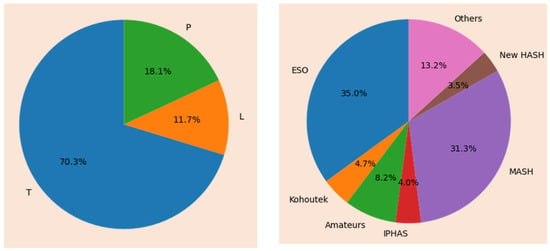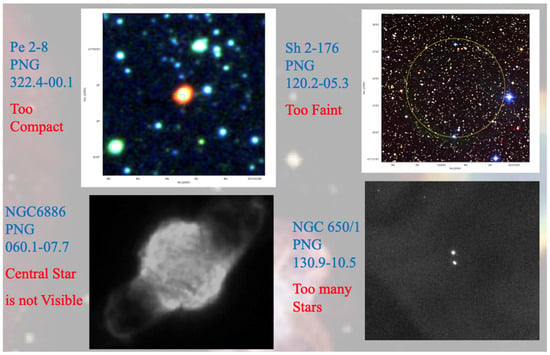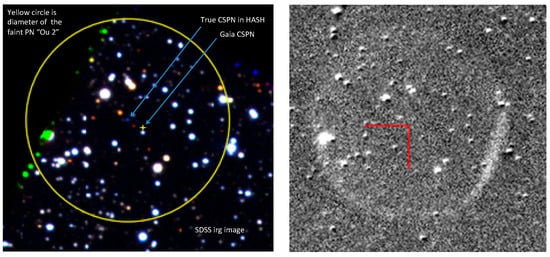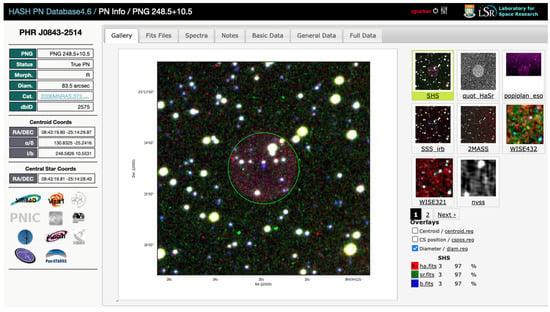Abstract
We present some preliminary findings on the population of planetary nebula where central stars (CSPN) have been independently identified in the HASH catalogue. Many new discoveries and candidates have been found (416 at the time of this writing), adding significantly to the previously known sample of about 600. We also present results from a comparison between our own HASH measurements of CSPN and those provided in existing CSPN catalogues and those from Gaia. We show the value of a federated, multi-wavelength database of Galactic PNe like HASH in terms of not only uncovering faint, new CSPN but of assisting in correct identifications, removing PN mimics with apparent CSPN, correcting incorrect assignments and providing improved positions. HASH provides the community with a comprehensive and reliable resource for any study of the CSPN population of Galactic PNe.
1. Introduction
Planetary Nebulae (PNe) represent a brief but important phase in the stellar evolution of low to intermediate mass stars where a final envelope ejection after the post AGB phase is ionized by the contracting and heating remaining stellar core. This causes this ejected nebula shroud to glow with a rich emission line spectrum that is a function of the UV radiation field intensity and the chemical composition and physical parameters of the shell. The PN central star (CSPN hereafter) drives this activity, and so the temperature, evolutionary state and type of the CSPN (and, indeed, whether it is in a binary system, e.g., [1]) are crucial for a better understanding of this key window into stellar evolution and its implications for ISM enrichment, mass return and stellar death rate. However, until recently, only about 20% of all known PNe had an equivocally identified CSPN [2] to help relate PN properties (such as the morphology, ionization state, kinematic age, etc.) to the underlying properties of the CSPN. These are known to be extremely varied, encompassing a wide variety of stellar types and characteristics ranging from pop II Wolf–Rayet stars ([WR]), different kinds of white dwarfs (DA, DAO, DO), PG1159 stars, Weak emission line stars (WLES), to early and late O(H) and Of(H) stars (e.g., [2,3]). A key reason CSPN are often hard to find is their generally extremely low luminosity. This is because although they are invariably hot, they are also residual stellar cores of a small size, typically similar to that of our earth. Hence, via the Steffan–Boltzmann Law, the luminosity can be very low, which, when coupled with their typically large distances, makes them difficult to find with even large telescopes. In many cases they are beyond the photometric limits of current surveys including Gaia. The MASH [4] and now HASH [5] PNe multi-wavelength database of all currently known Galactic and Magellanic Cloud PNe has provided a powerful, new resource for the community to study both PNe and their CSPN. Here we present preliminary results of the independently derived Galactic CSPN population now available through HASH and make some initial comparisons to the findings of [2], with preliminary Gaia results [6]; we also provide brief comments on what this means for the study of CSPN in general.
2. Materials and Methods
This work makes use of the HASH SQL database [5] and CSPN reported in [2] and preliminary CSPN from Gaia [6] along with software such as Python and visualization packages such as DS9. The HASH database is a key service for our global PN research community (HASH: Available online http://www.hashpn.space (accessed 26 January 2022)), hosted by the Laboratory for Space Research (http://www.lsr.hku.hk, accessed 26 January 2022) at the University of Hong Kong. HASH currently contains 3805 Galactic PNe (comprising 2668 True, 446 Likely and 691 possible PNe) plus 719 LMC & 102 SMC PNe + 6 others (e.g., in the Sagittarius dwarf)—refer to Figure 1. There are 4055 reduced 1-D fits spectra also available, and ~500,000 fits cutouts and ~88,000 color images from 20 major multi-wavelength surveys. HASH also provides direct clickable access for each catalogue entry to Simbad, Aladin, Vizier, MAST, PanSTARRs [7] and HST imagery, among other resources.

Figure 1.
Pie charts that show the current base properties of Galactic Planetary Nebula recorded in the HASH database: (Left panel): Fraction of HASH PNe that are designated as True (T), Likely (L) or Possible (P) PNe following [4,5]; (Right panel): Breakdown of all currently known 3805 Galactic PNe (T 2668, L 446, P 691) by major catalogue origin.
With the ever-improving multi-wavelength imaging surveys from different ground- and space-based projects, such as Gaia [6], PanSTARRs [7] and DECaPS [8], many more faint CSPN can now be uncovered. However, many distant CSPN have a very low luminosity with G > 20.7 and are so beyond the photometric limits of the Gaia astrometric survey. Indeed, the vast majority of known WDs have G > 21, although most have faded since they were CSPN. Weidmann [2] recently published a paper gathering 619 coordinates from all known CSPN. The paper [2] is a vetted compendium of CSPN reported from myriad sources over decades. For this paper, we manually checked all 619 entries in [2] against all the imagery and multi-wavelength surveys now conveniently available in HASH. The aim was to independently determine, using the federated power of HASH, the overall reliability of the Weidmann catalogue, including the accuracy and identification of the reported CSPN. Some serious issues were uncovered. Next, a comparison with ~37% of preliminary CSPN reported from Gaia was also undertaken, and some interesting findings were made. Finally, a careful, though admittedly subjective examination of all available imagery for ~55% of “True” Galactic PNe in HASH was performed by the first author, based on decades of experience. This was to independently look for CSPN previously missed or not previously visible from older, less sensitive and lower-resolution multi-band surveys compared to those now available in HASH that also benefit from more accurate astrometry. A significant number of new CSPN have been uncovered. The preliminary results from all these investigations are presented below. Once these tasks have been completed, a fuller paper will be submitted.
3. Results
We present our preliminary results based on three main investigations: First, a direct comparison between [2] and what HASH provides; next, an investigation into a randomly selected 37% sub-sample of the CSPN reportedly found by Gaia with confidence >0.85 and how these relate to HASH; and finally, a preliminary report on new CSPN independently uncovered by examining, so far, 1460 (~55%) of the 2668 HASH entries for True Galactic PNe.
3.1. Comparisons with the Weidmann Catalogue of CSPN
All 619 CSPN entries in [2] were carefully checked in HASH. There were 182 (~30%) CSPN in [2] for actual “True” PNe where we could not be confident that the CSPN had been correctly identified at the quoted position based on the examination of the available HASH imagery. Usually, corroboration was straightforward as the CSPN is both blue and located at or close to the PN’s geometric center. However, for ~30% of CSPN in [2] this is not the case. We assume here that the actual CSPN can be distinguished from the PN itself. However, in [2], it might be supposed that for compact PNe, even though the CSPN cannot actually be discerned, they have assumed that it must be located within the confines of the compact PN envelope and so have used the position of the PN as that of the CSPN. Of course, in such cases nothing can really be said about the type of CSPN that is located but indiscernible within the compact and usually high-surface-brightness PN. Figure 2 provides four examples of different situations where we were unable to confirm the CSPN listed in [2].

Figure 2.
Four examples of different situations where we were unable to confirm the CSPN listed in [2]. The annotation for each panel is self-explanatory.
We found the following results, as presented in Table 1. The largest group of 106 (17%) of the 619 CSPN entries from [2] concerns those compact PNe where no CSPN is evident in the available imagery, including high-resolution HST data when present.

Table 1.
This table provides the results of our examination of all 619 CSPN listed in [2] based on available HASH imagery, giving the main reason we cannot confirm the CSPN identification.
3.1.1. Issues with Object Classification
The CPSN listed in [2] made use of PN catalogues prior to HASH. Such compilations have been shown to be badly contaminated with a variety of mimics (see [9]), and these have been robustly excluded from HASH. In checking entries in [2], we found 47 objects (7.6%) that were not PNe according to HASH, as follows: 15 Symbiotic stars, 14 cases of ionized ISM, six HII regions, three transition objects, with the final nine being a combination of a variety of other PN mimics like Cataclysmic variables.
3.1.2. Astrometric Comparison and Integrity
After checking against HASH entries, the number of bona-fide CSPN of actual True PNe is only 370 out of the original 619 CSPN listed in [2]—see Table 2 for details. Of these 370, 263 (71%) have reported positions that agree with our own determinations to better than 1 arcsecond. However, 72 have positional differences of between 1 and <3 arcseconds, 15 have differences of >3 and <5 arcseconds, and for 20 we found differences of >20 arcseconds for the reported CSPN in [2] and the CSPN we identified in HASH. The smaller differences of <3 arcseconds are mostly astrometric errors in [2], while the larger discrepancies mostly reflect different stars that HASH is able to identify as the most likely CSPN based on access to the latest survey imagery. We believe these results present clear evidence that a significant fraction of CSPN identified in [2] are erroneous.

Table 2.
Comparison between 338 (~1/3rd random sample) of the 904 raw Gaia CSPN candidates with putative reliabilities >0.85 and what HASH reveals. We believe that many Gaia CSPN identifications need to be re-examined, though the EDR3 comparison will be better (in preparation).
3.2. Comparisons with the Gaia Astrometric Survey
Gaia [6] has also internally released the coordinates of 1935 putative CSPN (~50% of all current T, L, P HASH Galactic PNe), of which 904 (23.7%) have a quoted “reliability” factor of ≥0.85. We used the same individual HASH PN checking and verification procedure we applied to [2] for 338 out of these 904 “high confidence” Gaia CSPN as a ~1/3 randomly selected sample via standard techniques. Our preliminary results are surprising. Even with Gaia-assigned “high reliability” cases, by no means did CSPN in the Gaia catalogue all agree with our checking when using the best available imagery (refer to Table 2 below for specific details). Nevertheless, unlike for [2], no astrometric problems were found. Others [10,11,12,13] have been using Gaia Early Release data to identify CSPN, with [12] reporting results for 1725 Galactic CSPN based on Gaia EDR3 data. However, from our HASH study it is clear that there may be problems with these Gaia CSPN compilations, as Figure 3 clearly shows for PN ‘Outers 2′ (HASH ID #10957), where the available PanSTARRs and SDSS irg imagery reveals the true blue CSPN that is also right at the geometric center of the PN. The Gaia-identified CSPN from [12] is not correct. In some cases, the HASH imagery may also be an issue, as many PNe in HASH do not have PanSTARRs/SDSS imagery and most do not of course benefit from HST imagery.

Figure 3.
(Left): SDSS irg color RGB annotated image of PN Ou 2. (Right): IPHAS Hα/R band quotient image of Ou 2 that shows the round 90” diameter PN and the true CSPN location.
3.3. New CSPN Uncovered with HASH
As of January 2022, there are now 1063 Central stars identified for the 3805 Galactic PNe currently in HASH or about 28% of all PNe. This is expected to increase as the careful checking of all HASH PNe is completed by the end of 2022. This list includes all entries ingested from [2]. Note that only ~1400 True HASH PNe have been thoroughly checked so far to both confirm CSPN and to reveal the 415 new CSPN also uncovered. Incorrectly identified CSPN listed in [2] have been removed from HASH according to our verification processes above and in [9]. So far, 102 of the new CSPN are located at positive Galactic latitudes and 313 at negative Galactic latitudes. This simply reflects the wider coverage of H-alpha surveys in the Southern Hemisphere that has provided a large fraction of new PN discoveries over the last 20 years. Figure 4 gives an example of a HASH database image page for PN PHR J0843-2514, with the new blue CSPN clearly seen at the center of the round PN, while Table 3 shows the main survey resource used to identify new CSPN.

Figure 4.
HASH database page for PN PHR J0843−2514 showing the faint round PN and newly identified very faint blue CSPN at its geometric center. Some of the high-level functionality of HASH can be appreciated in this page in terms of external surveys accessed by clicking on the icons on the bottom left of the main HASH image page and the tab selection options at the top that allow online access to the fits images, spectral plots, basic data and more.

Table 3.
This table shows which available HASH imagery was used to uncover 332 of the 415 newly identified CSPN. For the other 83 cases, combinations of available image data were used.
4. Discussion
Determining the variation of the diverse population of CSPN is vital to understanding their host PNe and their morphologies, shaping mechanisms, energetics and the key role this important but brief phase of stellar evolution plays in Galactic chemical enrichment and the ISM mass budget. However, if we are to undertake such studies, we must first be confident that any identified CSPN is actually the bona-fide progenitor for the surrounding nebula and also try to ensure that we have uncovered as many CSPN as possible so that they are properly representative of the overall CSPN population. This study has made extensive use of our HASH database to undertake an independent, preliminary evaluation of CSPN. We find that only with a careful examination of every PN and CSPN candidate on an individual basis and by using all the power of multi-wavelength imagery and other pertinent data in HASH can proper evaluations be made and more reliable CSPN be identified. This appears to be true for both [2] and Gaia [10,11,12,13], where our results show some potential issues with correct CSPN identification. Fuller details and work on this topic will be the subject of a paper by Parker et al., which is in preparation.
Author Contributions
Conceptualization Q.A.P.; methodology Q.A.P., Z.X. and A.R.; software & validation, A.R., Q.A.P. and Z.X.; formal analysis, Z.X., Q.A.P. and A.R.; investigation, Q.A.P., Z.X. and A.R.; data curation, A.R.; writing—original draft preparation, Q.A.P. and A.R.; writing—review and editing, Q.A.P., A.R. and Z.X.; visualization, Z.X. and A.R.; supervision, Q.A.P.; project administration, Q.A.P.; funding acquisition, Q.A.P. All authors have read and agreed to the published version of the manuscript.
Funding
This research was funded by the Hong Kong Research Grants Council (RGC), grant numbers 17326116 and 17300417 awarded to Q.A.P., who thanks the RGC for this General Research Fund (GRF) research support. Z.X. thanks The University of Hong Kong (HKU) and the Laboratory for Space Research for his Summer Research Scholarship. A.R. thanks HKU and the RGC for funding his postdoctoral fellowship.
Data Availability Statement
Data supporting the reported results can be found in the HASH database. Available online: https://hashpn.space (accessed 26 January 2022), which includes many links to publicly archived datasets analyzed or generated during this study.
Conflicts of Interest
The authors declare no conflict of interest.
References
- Miszalski, B.; Parker, Q.A.; Acker, A.; Birkby, J.L.; Frew, D.J.; Kovacevic, A. MASH-II: More planetary nebulae from the AAO/UKST Hα survey. Mon. Not. R. Astron. Soc. 2008, 384, 525. [Google Scholar] [CrossRef][Green Version]
- Weidmann, W.A.; Mari, M.B.; Schmidt, E.O.; Gaspar, G.; Bertolami, M.M.M.; Oio, G.A.; Gutiérrez-Soto, L.A.; Volpe, M.G.; Gamen, R.; Mast, D. Catalogue of the central stars of planetary nebulae. Astron. Astrophys. 2020, 640, A10. [Google Scholar] [CrossRef]
- Weidmann, W.A.; Gamen, R.; Mast, D.; Farina, C.; Gimeno, G.; Schmidt, E.O.; Ashley, R.P.; de Arriba, L.P.; Sowicka, P.; Ordoñez-Etxeberria, I. Towards an improvement in the spectral description of central stars of planetary nebulae. Astron. Astrophys. 2018, 614, A135. [Google Scholar] [CrossRef]
- Parker, Q.A.; Acker, A.; Frew, D.J.; Hartley, M.; Peyaud, A.E.J.; Ochsenbein, F.; Phillipps, S.; Russeil, D.; Beaulieu, S.F.; Cohen, M.; et al. The Macquarie/AAO/Strasbourg H Planetary Nebula Catalogue: MASH. Mon. Not. R. Astron. Soc. 2006, 373, 79. [Google Scholar] [CrossRef]
- Parker, Q.A.; Bojicic, I.S.; Frew, D.J. HASH: The Hong Kong/AAO/Strasbourg Hα planetary nebula database. J. Phys. Conf. Ser. 2016, 728, 032008. [Google Scholar] [CrossRef]
- Collaboration, G.; Prusti, T.; de Bruijne, J.H.J.; Brown, A.G.A.; Vallenari, A.; Babusiaux, C.; Bailer-Jones, C.A.L.; Bastian, U.; Biermann, M.; Evans, D.W.; et al. The Gaia mission. Astron. Astrophys. 2016, 595, 36. [Google Scholar] [CrossRef]
- Chambers, K.C.; Magnier, E.A.; Metcalfe, N.; Flewelling, H.A.; Huber, M.E.; Waters, C.Z.; Denneau, L.; Draper, P.W.; Farrow, D.; Finkbeiner, D.P. The Pan-STARRS1 Surveys. arXiv 2016, arXiv:161205560C. [Google Scholar]
- Schlafly, E.F.; Green, G.M.; Lang, D.; Daylan, T.; Finkbeiner, D.P.; Lee, A.; Meisner, A.M.; Schlegel, D.; Valdes, F. The DECAM Plane Survey: Optical Photometry of Two Billion Objects in the Southern Galactic Plane. Astrophys. J. 2018, 234, 39. [Google Scholar] [CrossRef]
- Frew, D.J.; Parker, Q.A. Planetary nebulae: Observational Properties, Mimics and Diagnostics. Publ. Astron. Soc. Aust. 2010, 27, 129. [Google Scholar] [CrossRef]
- Gonzalez-Santamaria, I.; Manteiga, M.; Manchado, A.; Ulla, A.; Dafonte, C. Properties of central stars of planetary nebulae with distances in Gaia DR2. Astron. Astrophys. 2019, 630, A150. [Google Scholar] [CrossRef]
- Gonzalez-Santamaria, I.; Manteiga, M.; Manchado, A.; Gómez-Muñoz, M.A.; Ulla, A.; Dafonte, C. Wide binaries in planetary nebulae with Gaia DR2. Astron. Astrophys. 2020, 644, A173. [Google Scholar] [CrossRef]
- Gonzalez-Santamaria, I.; Manteiga, M.; Manchado, A.; Ulla, A.; Dafonte, C.; Varela, P.L. Planetary nebulae in Gaia EDR3: Central star identification, properties and binarity. Astron. Astrophys. 2021, 656, 51. [Google Scholar] [CrossRef]
- Chornay, N.; Walton, N.A. One star, two star, red star blue star: An updated planetary nebula central star distance catalogue from Gaia EDR3. Astron. Astrophys. 2021, 656, 110. [Google Scholar] [CrossRef]
- Hambly, N.C.; MacGillivray, H.T.; Read, M.A.; Tritton, S.; Thomson, E.; Kelly, B.; Morgan, D.; Smith, R.; Driver, S.; Williamson, J.; et al. The SuperCOSMOS Sky Survey—I. Introduction and description. Mon. Not. R. Astron. Soc. 2001, 326, 1279. [Google Scholar] [CrossRef]
- Boffin, H.M.J.; Jones, D.; Beletsky, Y.; van den Ancker, M.; Smoker, J.; Gadotti, D.; Saviane, I.; Moehler, S.; Ivanov, V.D.; Schmidtobreick, L.; et al. POPIPlan: A Deep Morphological Catalogue of Newly Discovered Southern Planetary Nebulaer. Messenger 2012, 148, 25B. [Google Scholar]
- Minniti, D.; Lucas, P.W.; Emerson, J.; Saito, R.; Hempel, M.; Pietrukowicz, P.; Ahumada, A.; Alonso, M.; Alonso-García, J.; Arias, J. VISTA Variables in the Via Lactea (VVV): The public ESO near-IR variability survey of the Milky Way. New Astron. 2010, 15, 10. [Google Scholar] [CrossRef]
- Lawrence, A.; Warren, S.J.; Almaini, O.; Edge, A.; Hambly, N.C.; Jameson, R.F.; Lucas, P.; Casali, M.; Adamson, A.; Dye, S.; et al. The UKIRT Infrared Deep Sky Survey (UKIDSS). Mon. Not. R. Astron. Soc. 2007, 379, 1599. [Google Scholar] [CrossRef]
- Parker, Q.A.; Phillips, S.; Pierce, M.J.; Hartley, M.; Hambly, N.C.; Read, M.A.; MacGillivray, H.T.; Tritton, S.B.; Cass, C.P.; Cannon, R.D.; et al. The AAO/UKST SuperCOSMOS Hα Survey. Mon. Not. R. Astron. Soc. 2005, 362, 689. [Google Scholar] [CrossRef]
- Drew, J.E.; Greimel, R.; Irwin, M.J.; Aungwerojwit, A.; Barlow, M.J.; Corradi, R.L.M.; Drake, J.J.; Gänsicke, B.T.; Groot, P.; Hales, A.; et al. The INT Photometric Hα Survey of the Northern Galactic Plane (IPHAS). Mon. Not. R. Astron. Soc. 2005, 363, 753. [Google Scholar] [CrossRef]
- Stoughton, C.; Lupton, R.H.; Bernardi, M.; Blanton, M.R.; Burles, S.; Castander, F.J.; Connolly, A.J.; Eisenstein, D.J.; Frieman, J.A.; Hennessy, G.S.; et al. Sloan Digital Sky Survey: Early Data Release. Astron. J. 2002, 123, 485. [Google Scholar] [CrossRef]
Publisher’s Note: MDPI stays neutral with regard to jurisdictional claims in published maps and institutional affiliations. |
© 2022 by the authors. Licensee MDPI, Basel, Switzerland. This article is an open access article distributed under the terms and conditions of the Creative Commons Attribution (CC BY) license (https://creativecommons.org/licenses/by/4.0/).